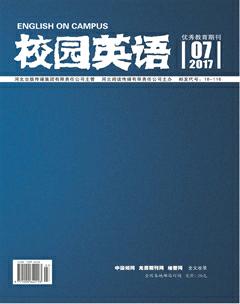The Use of Native Language in College English Class
黄云云
【Abstract】The essay probes into the main circumstances in which whether the multilingual approach with students native language or an exclusively monolingual approach should be used in college English class. The closely-related elements include the teacher, the students and the teaching activities.
【Key words】native language; college English class; multilingual; monolingual
Introduction
Using students native language has both benefits and shortcomings (Auerbach, 1993; Carless, 2008; Schweers, 2003). The answer to the question whether students native language should be used in college English class, as Lucas & Katz (1994) maintain, is when to use or not to use. The essay studies the question in the perspectives of the teacher, the students and the teaching activities. In this essay, students native language refers to Mandarin Chinese.
The Teacher
In addition to the whether the teacher shares students native language, whether the teacher speaks English as his native language is an important issue to be considered when making the decision. According to Bateman (2008), a teacher who teaches his native language as the target language feels less fatigue to use the monolingual approach than a teacher to whom the target language is also his foreign language.
The choice of language in college English class is also subject to the teachers competence and teaching experience. When the teacher is less competent or less experienced, the monolingual approach does not seem to be a good practice. Firstly, when the teacher is not proficient enough in English, although exclusively monolingual approach ensures the students sufficient exposure to English, the input is not always comprehensive enough to facilitate the students understanding. Secondly, rather than use students native language in class to facilitate English teaching, an experienced teacher can use many other ways to do the job. For example, when stopping students from an off-task talk, a seasoned teacher knows that he can simply stops talking and stare at the talking students for a few seconds instead of shifting from English to students native language. In this case, the teacher can use English-only approach. This gives an implication to the college English teacher training, as Grim (2010) suggests, that it is important to give language teachers pre-service training in both language knowledge and skills of managing the class.
The Students
When making the decision, the age and opinions of the students in college English class are also the elements to be taken into consideration.
The age of the students is an important factor in determining the appropriateness of using native language. Compared with children, college students have longer “attention span” (Bateman, 2008, p. 21), are stronger in the ability of comprehension and self-control. Therefore, the monolingual approach can be considered because the college students are generally more persistent, more motivated and more willing to accept the class overwhelmed by English.
Although teachers and researchers, based on their experience and judgments, all have a say on what teaching language policy benefits students, it is the students who know best whether it is the case. If the college students find it very difficult to learn English without the help of their native language, the teachers are suggested not to insist on using the monolingual approach without negotiating it with the students. If not, students may feel compelled.
The Teaching Activities
In a college English class, the exclusively monolingual approach is beneficial because it immerses the students in English. However, when what the teacher says in English cannot be well understood by the students, the teaching goal cannot be well achieved. In this situation, the students native language can be one of the most effective ways to make the communication flow. In other words, the use of students native language depends on different teaching activities at hand.
The monolingual approach is often chosen when reviewing familiar teaching points and in speaking activities. Despite of using students native language for explaining abstract topics, checking students comprehension and keeping order, prior studies also suggest that native language can be used in different activities in different stages of a college English class, such as warming students up for activities and talking about culture-related topics (Edstrom, 2006); expanding a teaching point (Nzwanga, as cited in Grim, 2010, p.195) and getting students quickly into tasks (Turnbull & Arnett, 2002). However, for example, when the students are already very familiar with the culture-related issue, there is no need to use the native language. In a word, the teachers are suggested to use the multilingual or the monolingual approach selectively.
Conclusion
The paper explores the use of students native language in college English class and finds out that it depends on whether the teacher is the native speaker of English and is competent and experienced enough, the age and opinions of the students, the teaching activities and goals. It is suggested that College English teachers choose the multilingual approach with native language or the monolingual approach selectively according to the changing situations of the class.
References:
[1]Auerbach,E.R.(1993).Reexamining English only in the ESL classroom.TESOL Quarterly,27(1),9-32.
[2]Bateman,B.E.(2008).Student teachers attitudes and beliefs about using the target language in the classroom.Foreign Language Annals,41(1),11-28.
[3]Carless,D.(2008).Student use of the mother tongue in the task-based classroom.ELT Journal,62(4),331-338.
[4]Edstrom,A.(2006).L1 use in the L2 classroom:one teachers self-evaluation.The Canadian Modern Language Review,63(2), 275-292.
[5]Grim,F.(2010).L1 in the L2 classroom at the secondary and college levels:a comparison of functions and use by teachers.Electronic Journal of Foreign Language Teaching,7(2),193-209.Retrieved January 5,2012,from http://e-flt.nus.edu.sg/v7n22010/grim.pdf.
[6]Lucas,T.,& Katz,A.(1994).Reframing the debate:the roles of native languages in English-only programs for language minority students.TESOL Quarterly,28(3),537-561.
[7]Schweers,C.W.(2003).Using L1 in the L2 classroom.English Teaching Forum,41(4),21,34-37.
[8]Turnbull,M.,& Arnett,K.(2002).Teachers uses of the target and first languages in second and foreign classrooms.Annual Review of Applied Linguistics,22(11),204-218.

